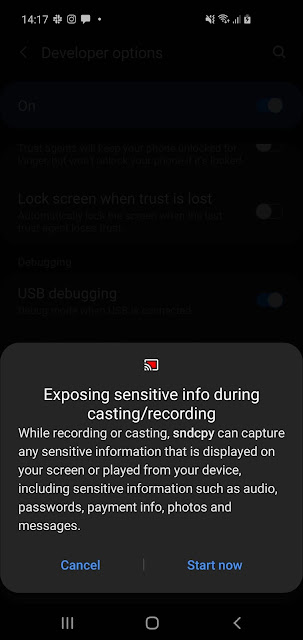sndcpy Forwards Audio From Android 10 To Linux, Windows Or macOS Desktop (Like scrcpy But For Audio)
sndcpy is like scrcpy, but for audio. This new tool forwards audio from an Android 10 device to a desktop computer running Linux, Windows or macOS.
Update: scrcpy now supports audio forwarding for Android devices to desktops.
You can use sndcpy to enable audio forwarding while mirroring your Android device to your desktop with scrcpy, the low-latency, high performance, free and open source tool to display and control android devices from a desktop. scrcpy ("screen copy") itself doesn't do audio forwarding, and this is where sndcpy ("sound copy") comes in.
Using sndcpy doesn't require root, but it does require the Android device have at least Android 10, have VLC installed on the desktop computer, and have USB debugging enabled on the Android device. The audio forwarding can be performed either via a USB cable, or wirelessly (in the same network) using adb connected over TCP/IP.
It's worth noting that using sndcpy, the volume can be adjusted independently on the device and on the computer. Also, the tool may only forward audio from apps which do not prevent audio capture - all apps that target Android 9 or older do not allow audio capture, preventing sndcpy to forward the audio (for example forwarding audio from Spotify playing on Android 10 doesn't work).
On Windows, download the
You can also build sndcpy from source.
This is how to use sndcpy. Start by connecting your Android 10+ phone with USB debugging enabled to your desktop, via USB.
Now extract the sndcpy zip archive, open a terminal, navigate to the folder where you've extracted sndcpy and run it on Linux / macOS:
On Windows, run sndcpy.bat instead:
Back on your phone, you should now see a screen requesting permission to start the audio capture:
Press
If you didn't authorize the current computer with your Android device using adb before, when running sndcpy for the first time make sure the Android device screen is unlocked, and that you authorize sndcpy (click
To wirelessly forward audio from your Android 10+ phone to your Linux, Windows or macOS desktop using sndcpy, make sure USB debugging is enabled on your phone and that both your desktop and Android device are connected to the same network, then connect the phone to your desktop via USB and run:
Next, unplug the Android device, and use adb to connect to your phone wirelessly using:
Replace
After you've done this, run sndcpy like normal (run this in the folder where you have extracted sndcpy):
You can use sndcpy to enable audio forwarding while mirroring your Android device to your desktop with scrcpy, the low-latency, high performance, free and open source tool to display and control android devices from a desktop. scrcpy ("screen copy") itself doesn't do audio forwarding, and this is where sndcpy ("sound copy") comes in.
 |
| Using scrcpy and sndcpy in the same |
Using sndcpy doesn't require root, but it does require the Android device have at least Android 10, have VLC installed on the desktop computer, and have USB debugging enabled on the Android device. The audio forwarding can be performed either via a USB cable, or wirelessly (in the same network) using adb connected over TCP/IP.
It's worth noting that using sndcpy, the volume can be adjusted independently on the device and on the computer. Also, the tool may only forward audio from apps which do not prevent audio capture - all apps that target Android 9 or older do not allow audio capture, preventing sndcpy to forward the audio (for example forwarding audio from Spotify playing on Android 10 doesn't work).
Download and how to use sndcpy
On Windows, download the
sndcpy-with-adb-windows-v1.0.zip binary which includes adb. On Linux and macOS, download sndcpy-v1.0.zip - you'll need to have adb installed on your system (be available in your PATH). On all Linux, Windows and macOS, you'll also need to have VLC installed.You can also build sndcpy from source.
This is how to use sndcpy. Start by connecting your Android 10+ phone with USB debugging enabled to your desktop, via USB.
Now extract the sndcpy zip archive, open a terminal, navigate to the folder where you've extracted sndcpy and run it on Linux / macOS:
cd sndcpy-v1.0
./sndcpyOn Windows, run sndcpy.bat instead:
sndcpy.batBack on your phone, you should now see a screen requesting permission to start the audio capture:
Press
Start now, then back to the terminal where you ran sndcpy, press the Enter key once you see this:./sndcpy
Waiting for device...
Success
Starting: Intent { act=android.intent.action.MAIN cat=[android.intent.category.LAUNCHER] cmp=com.rom1v.sndcpy/.MainActivity }
Press Enter once audio capture is authorized on the device to start playing...If you didn't authorize the current computer with your Android device using adb before, when running sndcpy for the first time make sure the Android device screen is unlocked, and that you authorize sndcpy (click
OK on the Android device when asked for authorization). The audio from your Android 10+ phone should now be forwarded to your Linux, Windows or macOS desktop.To wirelessly forward audio from your Android 10+ phone to your Linux, Windows or macOS desktop using sndcpy, make sure USB debugging is enabled on your phone and that both your desktop and Android device are connected to the same network, then connect the phone to your desktop via USB and run:
adb tcpip 5555Next, unplug the Android device, and use adb to connect to your phone wirelessly using:
adb connect DEVICE_IP:5555Replace
DEVICE_IP with the Android 10+ device IP. You can get the IP from About Phone -> Status.After you've done this, run sndcpy like normal (run this in the folder where you have extracted sndcpy):
- on Linux / macOS:
./sndcpy- on Windows:
sndcpy.bat







